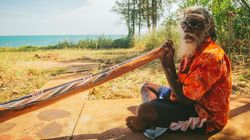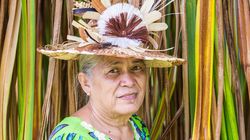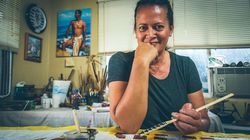Indigenous Hawaiian artist Dalani Tanahy spends weeks painstakingly beating tree bark into a sheets of cloth-like fabric. This ancient Hawaiian artform known as 'kapa' was once the staple material of the islands. But after Captain Cook introduced cotton, and the Americans overthrew the Hawaiian monarchy, kapa-making completely disappeared.
Dalani is one of a handful of dedicated practitioners who has spent her life bringing this artform back. Why? Because kapa-making has become integral to the nascent Hawaiian cultural nationalism that is taking hold in indigenous communities of Hawaii. Kapa-making has become a powerful source of pride and identity, but it's a lot of work. Trees have to be planted and tended, cut, stripped, and the bark beaten and fermented. Then sheets of bark are joined together to make a single sheet. Natural dyes and paints are printed on. And only then is the kapa ready to be worn.
Dalani takes us through the process of making a piece of kapa from start to finish, and delivers her kapa to a dancer, who plans to use this kapa as a traditional 'hula' skirt.
The film ends with an emotional performance at the Royal Palace in Honululu, Hawaii. A traditional 'hula' dance is performed, to honour Hawaii's last monarch, Queen Lilo'uokalani. Like the kapa itself, the Queen, rudely overthrown by Americans, has become a symbol of reborn Hawaiian identity.






